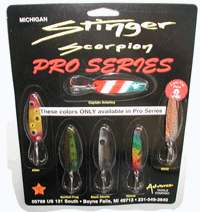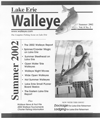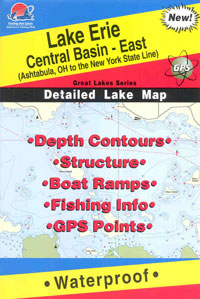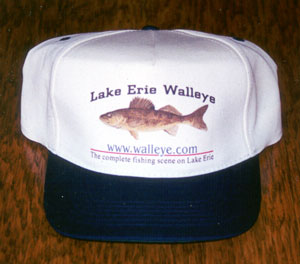|
Three T's of Fall
Transition, Turnover, and Trophy Walleyes
By Perry Good
As predator fish begin their fall feeding habits, their focus centers
on large forage.
 Young
of the year perch, cisco, river shiners and chubs, along with other
forage, such as frogs, crawfish and even their own offspring will be
targeted. Successful trophy hunters will match the hatch, almost
scientifically, at this time of year. Imitation of the forage base is
very critical and a key to productivity during the summer feeding binge! Young
of the year perch, cisco, river shiners and chubs, along with other
forage, such as frogs, crawfish and even their own offspring will be
targeted. Successful trophy hunters will match the hatch, almost
scientifically, at this time of year. Imitation of the forage base is
very critical and a key to productivity during the summer feeding binge!
Feeding forays are anything but mysterious! The fish have to eat a
lot as summer activity increases. The perdition cycle is in high gear on
reefs, large points and adjacent flats, and in neck down flowage areas.
Veteran anglers can predict these movements, and
position themselves for hot late summer or early fall action on the
biggest fish of the year. Big fish become vulnerable for longer periods
in the fall because they move into areas where baitfish are staging,
some remaining in the general area through winter. To catch walleyes
during fall transition and early fall consider the tendency for walleyes
to move up.
An obvious relationship exists between prey and walleye movements
during this transition period. Forage fish move shallow during turnover
and early fall because cooler water now becomes available there. And
walleyes follow their food to these areas. The sunlight penetration also
makes a big difference as to where the walleyes are located on any given
hump. You wouldn't think that sunlight penetration would go down as far
as 25 or 30 feet but in clear lakes it does. So when fishing, pay close
attention to the sun and make sure that you fish the shady side of that
hump. More active fish will be found in this area.
I prefer shallow rock humps with big, boulder-sized
rocks. I also prefer them to be fairly close in proximity to shore. They
don't necessarily have to be tied to the shoreline, but they should be
fairly close.
The rocks, if they are close enough to the surface,
absorb heat from the sun like a solar panel. The warmth attracts minnows
and you know the rest. A few scattered weeds growing up between the
rocks can be a real bonus.
Massive bait schools break up and walleyes head for
specific structural elements that funnel scattered, roaming forage past
specific spots. Look for long fingers or spines that protrude toward the
main lake. Roaming baitfish usually congregate along these fingers and
filter down them. Walleyes wait at the tips. Find those spots and you'll
find big walleyes. Bright warm days are preferred to cold, blustery
ones. The sun is lower in the sky this time of year, so light
penetration is decreased. However, bright days will cause the water to
warm up, which will turn fish on. Frequently, action will be better from
mid-day on. A wind coming into the rock pile can be advantageous,
although I have enjoyed some nice catches on, calm days. Remember that
the angle of the sun's rays is not as direct at this time of year so the
fish can be quite shallow. The direction of the wind will have a lot to
do with how the fish locate. Usually they will be working the windy side
of the rock pile.
These spots vary but are based on factors like: water
temperature, availability of baitfish, oxygen, light level, structure
and schooling tendencies. Success rests with proper presentation. Once
you have located the edge and fish, the next step is to entice them to
bite. Your bait presentation will depend upon the specific edge that you
have selected. If the walleyes are directly below and concentrated on a
physical edge you can backtroll a livebait rig, jig, or a bottom bouncer
rig, keeping the bait among the fish you see on the depthfinder. If you
find the fish strung out along the edge, keep the bait moving and they
will bite. If they're clumped up in one spot, hover over them and
vertically jig them.
Rocks also attract fish, try rocky shorelines. Rock
piles, humps or where rocks and weeds meet or are intermixed, work it
over thoroughly with a jig or live bait presentation. Try to determine
where fish are holding.
Keep asking yourself the question what is their
pattern? Constant bottom contact is essential even though it increases
the potential for snags. Use a small jig head with a wide hook gap to
deliver the bait in wavy conditions. Leeches are an outstanding rock
bait because they can take the pounding. Drifting the breakline on a
windy day is a way to catch trophy walleyes. The tackle is simple and
the methods are easy to learn. First, use jigs tipped with a crawler,
leech or minnow. The size of the jig should be just enough so you have
contact with the bottom. For example, on a river like the Mississippi, I
prefer to use 1/8 ounce or 1/4 ounce jigs. The important factor here is
the shape of the head. The head of the jig should be round or a stand-up
type of jig. This design helps when you. are in an area that has snags,
especially in timber or rocks. When I am on Mille Lac, I might switch to
a lighter jig, spinner or a live bait floater.
With the cooling temperatures and the rough and
tumble weather of fall don't put that boat away just yet, get out and
fish the edges for some fall transitional walleyes. You might be
surprised at the wallhanger you hook into.
|





 Young
of the year perch, cisco, river shiners and chubs, along with other
forage, such as frogs, crawfish and even their own offspring will be
targeted. Successful trophy hunters will match the hatch, almost
scientifically, at this time of year. Imitation of the forage base is
very critical and a key to productivity during the summer feeding binge!
Young
of the year perch, cisco, river shiners and chubs, along with other
forage, such as frogs, crawfish and even their own offspring will be
targeted. Successful trophy hunters will match the hatch, almost
scientifically, at this time of year. Imitation of the forage base is
very critical and a key to productivity during the summer feeding binge!